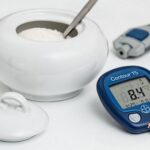What is colon cancer?
The colon and rectum make up the lower part of the digestive system. Colon cancer begins in the colon (large intestine) or rectum, when cells in the large intestine and rectum grow out of control.
More obviously, colon cancer begins when healthy cells in the lining of the colon or rectum grow out of control, forming a mass called a polyp.
The tumor is not in all cases cancerous, it can be benign. Cancerous tumor: It is a malignant tumor, which can grow and spread to other parts of the body. As for a benign tumor: it can grow, but without spreading.
The development and growth of these cells takes many years, and is influenced by several factors, which may be genetic or environmental. However, when a person has an uncommon genetic syndrome, changes in the cells can occur over only months or years.
According to the American Cancer Society (ACS), about 1 in 23 men and 1 in 25 women will develop colorectal cancer during their lifetime.
Symptoms of colon cancer
In most cases of colorectal cancer, there are no symptoms, especially in the early stages. A person may have polyps or cancer and not know it. Herein lies the importance of regular screening for colorectal cancer. Here are the most common colon cancer symptoms by stage:
1. Symptoms of stages 0 to 2
- constipation or diarrhea
- bloating or gas
- Colic.
- Tummy ache.
- Stool color change.
- Change in the shape of the stool.
- The appearance of blood in the stool.
- bleeding from the rectum
These are all symptoms that may have other, less severe causes of colon cancer, but it is best to see a doctor if you have been suffering from them for more than two weeks.
2. Symptoms of stage 3 or 4 (the late stage)
In addition to the symptoms of the early stages of colon cancer, symptoms appear more severely during stages 3 and 4. The following are the most prominent:
- Excessive fatigue and unjustified weakness.
- Appetite disturbances.
- Weight loss.
- Stool changes for more than a month.
- Stomach upsets, where you feel like your bowels won’t empty completely.
- Nausea or vomiting.
3. Colon cancer symptoms spread to other parts of the body:
- Chronic headache.
- blurry vision
- breathing difficulties
- Jaundice (yellowing of the eyes and skin).
- Swelling of the hands or feet.
- bone fractures
What is the difference between symptoms of colitis and colon cancer?
Cancer is when normal cells mutate and multiply abnormally, and it is dangerous because of its growth and potential for spread.
In colon cancer, abnormal cells grow and spread through the colon wall to include nearby lymph nodes and organs. It may spread to some distant organs such as: liver, lungs, brain, and bones.
Ulcerative colitis is not cancer. It is a type of inflammatory bowel disease (IBD) that includes both ulcerative colitis and Crohn’s disease. Ulcerative colitis causes:
- inflammation.
- irritation.
- swelling.
- Abdominal pain.
- Ulcers in the inner lining of the colon.
- Tired.
- Anemia due to blood loss and rectal bleeding.
- Frequent bowel movements.
- exhaustion.
Colon cancer spreads to other organs of the body, while ulcerative colitis only occurs in the large intestine.
Ulcerative colitis can’t be cured, but its symptoms and recurrences can be controlled with medication and lifestyle changes.
As for colon cancer, its recovery and survival rates depend on: the type of cancer, its stage, and the health of the individual.
Causes of colon cancer and factors that can influence the onset and severity of symptoms
Normally, cells live according to an organized process of growing, dividing, and then dying. Cancer occurs when cells grow and divide abnormally and do not die.
Researchers are still not sure of the exact causes of colon cancer, but there are factors that increase your risk:
1. Intracellular DNA changes:
In healthy cases, certain genes called oncogenes help cells survive, grow, and then divide, and tumor suppressor genes help regulate cell division and death.
In the event that changes occur in the DNA within cells, this may affect oncogenes and tumor suppressor genes, leading to colon cancer.
2. Transformation of benign tumors:
Non-cancerous benign tumors form inside the colon, on the inner walls of the large intestine, and cancer can start with some of these benign tumors. Therefore, people with benign tumors are considered at risk of developing colon cancer.
Colon cancer risk factors
Risk factors increase the possibility of colon cancer, but having one does not mean that you will necessarily develop cancer.
Knowing your risk factors for colon cancer and talking about them with your doctor will help you make more appropriate choices for your lifestyle. Here are the most prominent ones:
1. Age
Colon cancer may occur in young adults and adolescents of any age, but most cases of colon cancer occur in people over the age of 50.
The average age for men diagnosed with colon cancer is 68 years, and for women, the average age in most cases is 72 years.
2. Family medical history
Colon cancer is one of the most common cancers in families. This cancer may spread in the family if first-degree relatives, that is, parents, siblings, children, or the rest of the other family members, have colon cancer.
Also, between 5% and 6% of infections are associated with inherited gene mutations, which is why you should evaluate your inherited mutations through: review of personal and family history of cancer, and molecular testing of tumor tissue.
3. Genetic defect
You may have a genetic defect that makes you more likely to develop colon cancer and other types of cancer. This genetic defect includes the following conditions:
- Lynch syndrome (hereditary nonpolyposis colorectal cancer).
- Familial adenomatous polyposis.
- Gardner’s syndrome.
- Muir-Turi syndrome.
- Peutz-Jeghers syndrome.
4. Poor diet
Including red and processed meat in the diet is significantly associated with an increased risk of colon cancer.
Types of colon cancer
In colon cancer, there are different types of precancerous cells, as well as cells that grow in different parts of the digestive system, that can lead to colon cancer. Here are the most common types of colon cancer:
1. A trophic tumor
A trophoenoma is the most common type of colon cancer. It starts from adenomas, which form inside the cells that make mucus in the colon or rectum. It is one of the most common cases of colon cancer.
2. Carcinoid tumor
A carcinoid, or carcinoid tumor, begins in the hormone-producing cells within the intestine.
3. Other types of colon cancer
In addition to the two previous types, there are other types of colon cancer, which occur less commonly. like:
- Sarcomas: They form in soft tissues, such as: the muscles of the colon.
- Lymphoma: It begins in the lymph nodes or in the colon.
- Gastrointestinal stromal tumors: they start as benign tumors and then turn into cancerous tumors. These tumors form more clearly in the digestive tract, and rarely in the colon.
Stages of colon cancer
Recognizing the stages of colon cancer is a guiding system that doctors adopt to know the extent of the cancer, it is important to know the cancer in order to be able to determine the best method of treatment.
1. Stage 0 colon cancer
This stage is known as in situ carcinoma, during which abnormal cells are found only in the inner lining of the colon or rectum.
2. Stage I colon cancer
The cancer has penetrated the lining or mucous membrane of the colon and may have spread to the muscular layer. without spreading to nearby lymph nodes or other parts of the body.
3. Stage II colon cancer
Colon cancer in this stage has spread to the walls of the colon or rectum, or through the walls to nearby tissues.
4. Stage III colon cancer
During stage III colon cancer has metastasized to the lymph nodes, but not to other parts of the body.
5. Stage IV colon cancer
At this stage, the cancer has spread to other distant organs, such as the liver and lungs.
Colon cancer diagnosis
The American College of Gastroenterology recommends routine colon cancer screening by age 40.
An early diagnosis of colon cancer provides a good chance for a cure. However, the lack of symptoms during the early stages does not provide an opportunity to detect it in a timely manner.
During the diagnosis, your doctor will begin by asking questions about your medical and family history, performing a physical examination, and performing a colonoscopy to determine if there are any polyps or lumps.
1. Stool test
A stool test is performed to detect hidden blood in the stool. There are two types of this test:
-
Fecal occult blood test (gFOBT)
A special card on which the stool sample is placed is coated with the plant material called guaiac. If any blood appears in the stool, the color of the card will change.
Before taking this test, you will have to avoid certain foods such as red meat and certain nonsteroidal anti-inflammatory drugs (NSAIDs) so that they do not interfere with your test results.
-
Fecal immunochemical test (FIT)
This test detects hemoglobin in the blood and is more accurate than the fecal occult blood test. Through this test it is detected if there is bleeding in the upper gastrointestinal tract.
2. Blood tests
Blood tests are done to better understand what’s causing your symptoms and rule out other diseases and disorders.
3. Sigmoidoscopy
The doctor performs a minimally invasive sigmoidoscopy exam to look for abnormalities through a flexible tube with a light on it. For an early diagnosis, it is best to have a flexible sigmoidoscopy every 5 years, or every 10 years with an annual FIT exam.
4. Colonoscopy
Colonoscopy is performed using a long tube with a small camera at the end. This examination allows the doctor to see inside the colon and rectum.
During endoscopy, the doctor may also remove abnormal tissue, and then send samples of this tissue to a laboratory for analysis.
5. X-rays
The doctor inserts the barium chemical liquid into your intestines through an enema. The barium solution coats the lining of your colon. This helps in improving the quality of x-ray images.
6. CT scan
Through a CT scan, the doctor obtains a detailed picture of the colon.
Colon cancer treatment
Before prescribing the appropriate treatment, the doctor will take into account the type and stage of cancer, the age of the patient, and the patient’s general health. Treatment methods include surgery, chemotherapy and radiotherapy, the goal of which is to remove the cancer and prevent its spread.
1. Surgery
Surgery may be performed during the early stage, i.e. polypectomy, to remove the cancerous tumor, if the cancer is only present in the benign tumor.
In other stages, the doctor may need to remove part of the colon that contains cancer or the entire colon (colectomy).
After removing part of the colon, the surgeon either reconnects the healthy part or creates a stoma (a surgical opening in the abdominal wall, through which waste passes in a bag), depending on the extent of the colectomy.
2. Chemotherapy
Chemotherapy targets rapidly dividing cells by disrupting proteins or DNA. The drugs travel through the entire body, and treatment takes place in cycles, as the body has time to heal between doses.
Your oncologist recommends chemotherapy for colon cancer before surgery, to shrink the tumor and make it easier to remove. And after surgery, to kill the remaining cancer cells.
3. Radiotherapy
Radiation therapy kills cancer cells by focusing high-energy gamma rays on them.
Radiation therapy can be a standalone treatment to shrink a tumor, and it can also be effective in combination with other cancer treatments.
In colon cancer, radiotherapy is not given until the disease reaches its late stages.
Among the side effects of radiotherapy, which disappear after treatment is terminated: skin changes similar to sunburn, nausea, vomiting, diarrhea, fatigue, and loss of appetite.











